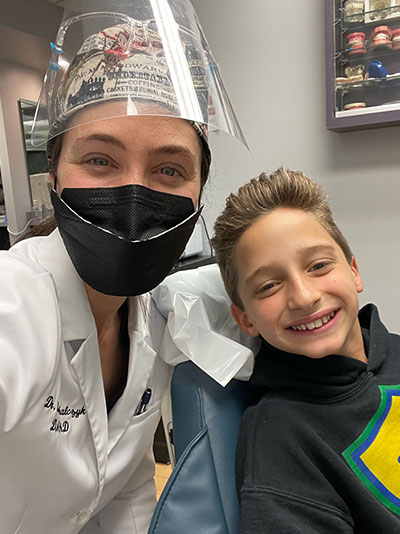Advanced Orthodontics
Surgical Orthodontics
Surgical orthodontics, also known as orthognathic surgery, is a type of orthodontic treatment combined with surgery to correct severe cases involving bite discrepncies that are too severe to correct with orthodontics alone. These include severe overbites, underbites, open bites, crossbites, and any other significant malocclusion.
Forever Smiles is a leading scientific and clinical practice, renowed for their knowledge and expertise involving jaw abnormalities and dysfunctional bites. Your orthodontist will work closely with an oral and maxillofacial surgeon in order to treat these complex craniofacial cases (involving the mouth, jaw, face, and/or skull). Forever Smiles' background in research and clinical cases involving surgical orthodontics and bone engineering will ensure that you are treated in an optimal and efficient way. Their research and clinical background in the international and domestic field makes them leading experts in orthognathic surgical cases.
When might surgical orthodontics be needed?
Surgical orthodontics may be used to treat adults with improper bites or other aesthetic concerns. Typically, jaw growth stops by age 16 in females and 18 in males. In order to receive orthognathic surgery, the orthodontist and oral surgeon will need to examine you before planning the treatment. Ideally, the orthodontist needs to begin observing the growth of the jaws at age seven, but any time after that may require orthodontics combined with surgery.
The need for surgical orthodontics occurs when the jaws do not line up correctly, and a proper bite cannot be achieved with orthodontic treatment alone. Orthognathic surgery will help properly align the jaw, and orthodontic braces will be used to move the teeth into their proper position.
How do I know if I need orthognathic surgery?
Drs. Michalczyk and Razdolsky can tell you if orthognathic surgery is needed as part of your treatment. Depending on the severity of your case and the alignment of your jaw, you may or may not need surgery.
How does orthognathic surgery work?
An oral and maxillofacial surgeon will perform your orthognathic surgery in a private practice setting or hospital, depending on the facility. Orthognathic surgery can last several hours depending on each individual case. Since orthognathic surgery is a major treatment, we recommend you schedule some time away from work and school during the healing process. Once the surgery is complete, you will have about a two week rest period, after which you will go back to the orthodontist to complete your treatment.
After surgery, you will continue to wear your braces. Most braces are removed within six to 12 months following surgery. After your braces are removed, you will wear a retainer to help maintain the position of your new bite and smile.
What are the risks associated with orthognathic surgery?
As with any major medical surgery, there may be certain risks of having orthognathic surgery. Orthognathic surgery has been performed for over two centuries and was modernized in the late 1950s.
If you’re concerned about an upcoming treatment with orthognathic surgery, please contact our practice and let us know. We are happy to answer any questions that you may have, and provide you with any additional information. Your comfort is important to us.
What are the rewards of having orthognathic surgery?
For many patients, the most gratifying reward of orthognathic surgery is achieving a beautiful and healthy smile that lasts a lifetime. Whether you need orthodontic treatment to correct a dysfunctional bite or jaw abnormality, orthognathic surgery can help restore your bite and protect/save your teeth in the longterm, as well as leave you with a confident smile for many years to come.
Dentofacial Orthopedics
Forever Smiles orthodontists specialize in “orthodontics and dentofacial orthopedics.” This is one of the nine specialties that are sanctioned by the American Dental Association. Others include pediatric dentistry (dentistry for children), periodontics (dentistry focusing on the gums), oral and maxillofacial surgery, dental public health, oral and maxillofacial pathology (tumors, cysts, malformations inside of the skull/jaw), endodontics (root canal treatment), and prosthodontics (dental prosthetics).
While orthodontics entails the management of tooth movement, dentofacial orthopedics involves the guidance of facial growth and development, which occurs largely during childhood. This makes it extremely important to see an orthodontist starting at the age of seven in order to properly monitor the development of growth and/or catch any abnormalities early on, thus setting your child up for success in the future.
Appliances are frequently used — the more familiar braces for orthodontics, and other specialized appliances like headgear and expanders, depending on what facial abnormalities are present. Sometimes orthopedic treatment may precede conventional braces (i.e. Phase One treatment), but often the two are used at the same time. So if your youngster gets braces combined with either an expander and/or headgear, they are actually undergoing orthodontics and dentofacial orthopedics.
Being skilled in both areas, the orthodontists at Forever Smiles are able to diagnose any misalignments in the teeth and jaw as well as the facial structure, and can devise a treatment plan that integrates both the orthodontic and dentofacial orthopedic treatments necessary.



